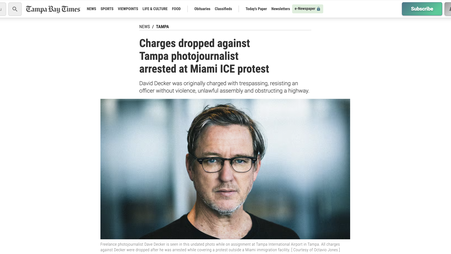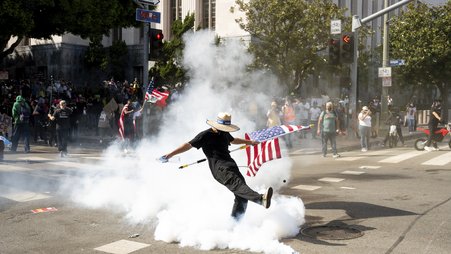
After a tumultuous 2020 saw unprecedented numbers of journalists arrested and detained, some held hope that police departments would learn from public backlash and change their behavior. In a coordinated crackdown on protests that included the arrest or detention of more than a dozen journalists, the Los Angeles Police Department showed last week that it has done no such thing.
Even before this week, the LAPD was engaging in shameful behavior in interacting with journalists, earlier this year pressing on with dubious charges against a journalist whose video showing officers damaging his equipment had gone viral and prompted an internal affairs investigation. In February, prosecutors told the journalist in question that no charges would be filed at that time, but that they could come later.
In a notable coincidence, both the journalist subject of that story and one of the authors of the Los Angeles Times article about his case were detained by police while covering protests near Echo Park Lake on Thursday night — two of at least 20 journalists who were detained, arrested, or assaulted while covering the protests. James Queally, the LA Times reporter, joked while being held in zip ties: “What is this, arrest journalist night?”
It’s no laughing matter. The LA Times editorial board laid it out clearly in a bracing opinion piece titled bluntly “In arresting journalists, LAPD hasn’t learned its lessons from 2020.” The board writes: “Policing angry protests is tense and hazardous work, and it’s easy for officers to err in the heat of the moment. Yet arrests of journalists as they do their jobs signal that the department has not yet learned its 2020 lessons.”
And there were certainly lessons to learn. Indeed, in 2020, Los Angeles was one of the cities in which journalists were most likely to be detained or arrested, with incidents reported during the summer of protests in response to the killing of George Floyd, at events celebrating the Dodgers clinching the World Series title, rallies related to the presidential election, and more.
The issue is sufficiently widespread that last year, California legislators advanced a bill that would have expanded protections for journalists covering protests, and explicitly excluded them from citation for failure-to-disperse or curfew-violation charges. That bill was introduced in February, and only got more attention throughout the year as incidents came to the fore, including the highly publicized arrest in Los Angeles of KPCC reporter Josie Huang, wherein video evidence contradicted law enforcement statements about how and why she was detained.
(Governor Gavin Newsom ultimately vetoed the bill, citing concerns that its definition of journalist, found elsewhere in the California Penal Code, could be interpreted to include “white nationalists, extreme anarchists or other fringe groups with an online presence.” That disappointing excuse echoes arguments against the bill from law enforcement groups.)
The problem isn’t limited to the behavior of officers on the ground, either. California passed new police transparency legislation in 2018 that police agencies and unions opposed, failed to comply with, and went to court over, opposite the First Amendment Coalition and multiple news organizations. That police resistance to transparency extends far beyond the LAPD in particular, of course.
Especially after the embarrassing failed prosecution of journalist Andrea Sahouri in Iowa — arrested while covering a Des Moines protest last year and found not guilty after less than two hours of jury deliberation in March — law enforcement officers and agencies should learn the lesson that criminalizing the work of reporters is not just bad for essential press freedom, but it’s also an ineffective and expensive mismanagement of public resources. California and Los Angeles deserve better.




